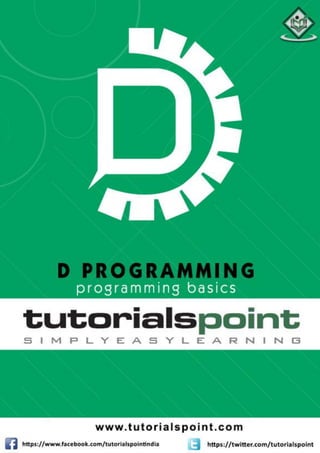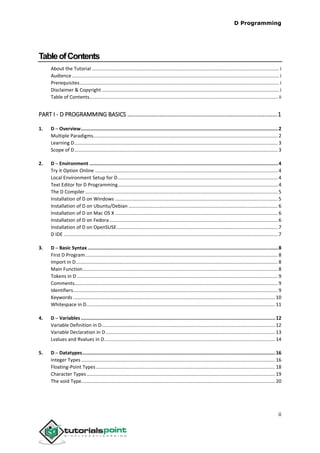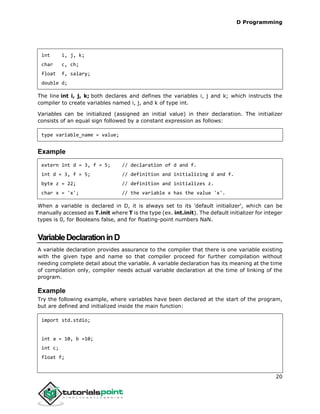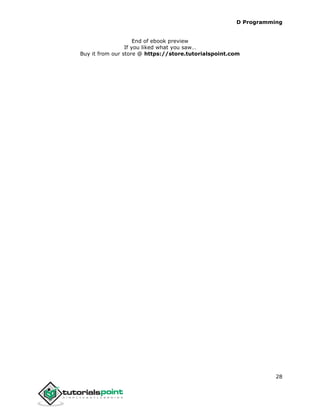The document is an in-depth tutorial on the D programming language, an object-oriented, multi-paradigm system programming language developed by Walter Bright. It covers various topics from basic syntax to advanced object-oriented programming concepts, targeting both beginners and advanced users. Additionally, it provides guidance on environment setup and includes examples and references for learning D programming effectively.










![D Programming
10
Example
import std.stdio;
void main(string[] args)
{
writeln("Hello World!");
}
LearningD
The most important thing to do when learning D is to focus on concepts and not get lost in
language technical details.
The purpose of learning a programming language is to become a better programmer; that is,
to become more effective at designing and implementing new systems and at maintaining old
ones.
ScopeofD
D programming has some interesting features and the official D programming site claims that
D is convenient, powerful and efficient. D programming adds many features in the core
language which C language has provided in the form of Standard libraries such as resizable
array and string function. D makes an excellent second language for intermediate to advanced
programmers. D is better in handling memory and managing the pointers that often causes
trouble in C++.
D programming is intended mainly on new programs that conversion of existing programs. It
provides built in testing and verification an ideal for large new project that will be written with
millions of lines of code by large teams.](https://image.slidesharecdn.com/dprogrammingtutorial-180726121223/85/D-programming-tutorial-11-320.jpg)
![D Programming
11
TryitOptionOnline
You really do not need to set up your own environment to start learning D programming
language. Reason is very simple, we already have set up D Programming environment online
under “Try it” option. Using this option, you can build and execute all the given examples
online at the same time when you are learning theory. This gives you confidence in what you
are reading and checking the result with different options. Feel free to modify any example
and execute it online.
Try following example using Try it option available at the top right corner of the below sample
code box:
import std.stdio;
void main(string[] args)
{
writeln("Hello World!");
}
For most of the examples given in this tutorial, you will find Try it option, so just make use
of it and enjoy learning.
LocalEnvironmentSetupforD
If you are still willing to set up your environment for D programming language, you need the
following two softwares available on your computer, (a) Text Editor,(b)D Compiler.
TextEditorforDProgramming
This will be used to type your program. Examples of few editors include Windows Notepad,
OS Edit command, Brief, Epsilon, EMACS, and vim or vi.
Name and version of text editor can vary on different operating systems. For example,
Notepad will be used on Windows, and vim or vi can be used on windows as well as Linux or
UNIX.
The files you create with your editor are called source files and contain program source code.
The source files for D programs are named with the extension ".d".
2. D ─ ENVIRONMENT](https://image.slidesharecdn.com/dprogrammingtutorial-180726121223/85/D-programming-tutorial-12-320.jpg)
![D Programming
12
Before starting your programming, make sure you have one text editor in place and you have
enough experience to write a computer program, save it in a file, build it and finally execute
it.
TheDCompiler
Most current D implementations compile directly into machine code for efficient execution.
We have multiple D compilers available and it includes the following.
DMD - The Digital Mars D compiler is the official D compiler by Walter Bright.
GDC - A front-end for the GCC back-end, built using the open DMD compiler source
code.
LDC - A compiler based on the DMD front-end that uses LLVM as its compiler back-
end.
The above different compilers can be downloaded from D downloads
We will be using D version 2 and we recommend not to download D1.
Let’s have a helloWorld.d program as follows. We will use this as first program we run on
platform you choose.
import std.stdio;
void main(string[] args)
{
writeln("Hello World!");
}
InstallationofDonWindows
Download the windows installer.
Run the downloaded executable to install the D which can be done by following the on screen
instructions.
Now we can build and run a d file say helloWorld.d by switching to folder containing the file
using cd and then using the following steps:
C:DProgramming> DMD helloWorld.d
C:DProgramming> helloWorld
We can see the following output.
hello world](https://image.slidesharecdn.com/dprogrammingtutorial-180726121223/85/D-programming-tutorial-13-320.jpg)


![D Programming
15
D is quite simple to learn and let’s start creating our first D program!
FirstDProgram
Let us write a simple D program. All D files will have extension ".d". So put the following
source code in a test.d file.
import std.stdio;
/* My first program in D */
void main(string[] args)
{
writeln("test!");
}
Assuming D environment is setup correctly, lets run the programming using:
$ dmd test.d
$ ./test
We will get the following output.
test
Let us now see the basic structure of D program, so that it will be easy for you to understand
basic building blocks of the D programming language.
ImportinD
Libraries which are collections of reusable program parts can be made available to our project
with the help of import. Here we import the standard io library which provides the basic I/O
operations. writeln which is used in above program is a function in D's standard library. It is
used for printing a line of text. Library contents in D are grouped into modules which is based
on the types of tasks that they intend perform. The only module that this program uses is
std.stdio, which handles data input and output.
MainFunction
Main function is the starting of the program and it determines the order of execution and how
other sections of the program should be executed.
3. D ─ BASIC SYNTAX](https://image.slidesharecdn.com/dprogrammingtutorial-180726121223/85/D-programming-tutorial-16-320.jpg)












